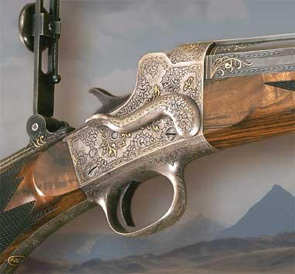

 The Accurate Reloading Forums
The Accurate Reloading Forums  THE ACCURATE RELOADING.COM FORUMS
THE ACCURATE RELOADING.COM FORUMS  Rifles
Rifles  Single Shot Rifles
Single Shot Rifles  Does the "Thin Web Thickness" concern you?
Does the "Thin Web Thickness" concern you?Go  | New  | Find  | Notify  | Tools  | Reply  |  |
| one of us |
Back some time ago there was this picture of a Blown-Up Single Shot Barrel on the GunSmith Board. Everyone decided it was due to the Flutes being cut too deep, but I'm not talking about that. As I looked at that flick, I got focused on the remaining "Thin Web Thickness" left after the holes are drilled and tapped for the Scope Bases. I had a Contender at one time and it never really crossed my mind back then. But as I think about it, the same thing obviously applies to any "Barrel" manufactured with Scope Base Screw Holes above the Chamber. Of course, the larger the Case Diameter, the thinner the remaining material happens to be. And a Cartridge rated at a high SAAMI Pressure would intensify the Stress at those "thin" spots. Does the "Thin Web Thickness" concern you when Developing Loads? | ||
|
| one of us |
I don't think about in with MY guns for one good reason: I never chamber anything larger than a .308 case head size in the Encore. I know lots of folks want Ultra Mags & WSMs, etc., on the Encore platform, but I don't think they are well-suited for such use. But that's just my .02... Bobby Μολὼν λαβέ The most important thing in life is not what we do but how and why we do it. - Nana Mouskouri | |||
|
| One of Us |
I wouldn't worry about it at all. Something else would give first. Even if the screw holes went all the way into the barrel, it probably wouldn't cause a burst. That's a very tiny spot for the pressure to work on. It might blow a screw out if the threads were cut sloppy with little contact (<50%). I recall in Gen Hatcher's notebook, IIRC, where he decided to see just what point a thin wall became dangerous. Figuring the pressures were highest over the chamber, he turned down a springfield barrel over the chamber, and kept shooting it after taking more metal off. Finally it was down to 1/16" (chamber wall thickness) IIRC, and it still held fine (using std military loads) with no change in dimensions. He then started using high pressure proof loads, and eventually had to go to a very high pressure load to get it to rupture. This was an extreme, but it demonstrates how much margin of safety there is in normal pressure loads. The only (barrel rupture) blow-ups I've seen were cases of extreme pressure, either from obstructions or handloading mistakes. "You can lead a horticulture, ... but you can't make 'er think" Florida Gardener | |||
|
| One of Us |
In 9mm and 40SW case head sizes, .1" heat treated steel chamber wall is good for overloads that make the primer fall out. .6" steel may split the chamber. You can do a hoop stress analysis [thin wall, thick wall, or Roark] on the steel and brass, given the pressure, but the massive failure alway takes more pressure than predicted. And remember, as many blow ups are caused by stuck bullets, Copper fouling, lead fouling, or cleaning rods left in the bore as are caused by overloads. Look for a barrel that has a long split. | |||
|
| Powered by Social Strata |
| Please Wait. Your request is being processed... |
|
 The Accurate Reloading Forums
The Accurate Reloading Forums  THE ACCURATE RELOADING.COM FORUMS
THE ACCURATE RELOADING.COM FORUMS  Rifles
Rifles  Single Shot Rifles
Single Shot Rifles  Does the "Thin Web Thickness" concern you?
Does the "Thin Web Thickness" concern you?

Visit our on-line store for AR Memorabilia

